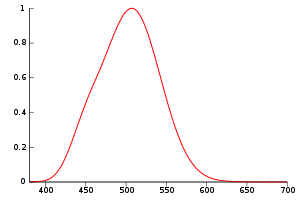
Scotopic vision
Encyclopedia

Human eye
The human eye is an organ which reacts to light for several purposes. As a conscious sense organ, the eye allows vision. Rod and cone cells in the retina allow conscious light perception and vision including color differentiation and the perception of depth...
under low light conditions. The term comes from Greek skotos meaning darkness and -opia meaning a condition of sight. In the human eye cone cells are nonfunctional in low light – scotopic vision is produced exclusively through rod cells which are most sensitive to wavelengths of light around 498 nm (green-blue) and are insensitive to wavelengths longer than about 640 nm (red). Scotopic vision occurs at luminance
Luminance
Luminance is a photometric measure of the luminous intensity per unit area of light travelling in a given direction. It describes the amount of light that passes through or is emitted from a particular area, and falls within a given solid angle. The SI unit for luminance is candela per square...
levels of 10−2 to 10−6 cd
Candela
The candela is the SI base unit of luminous intensity; that is, power emitted by a light source in a particular direction, weighted by the luminosity function . A common candle emits light with a luminous intensity of roughly one candela...
/m². In other species, such as the Elephant Hawk-moth (Deilephila elpenor), advanced color discrimination is displayed. Night-vision goggles and similar devices take advantage of the fact that human eyesight is most sensitive to light with a wavelength of 540 nm (slightly lime green).
Mesopic vision
Mesopic vision
Mesopic vision is a combination of photopic vision and scotopic vision in low but not quite dark lighting situations. Mesopic light levels range from luminances of approximately 0.001 to 3 cd m-2. Most night-time outdoor and traffic lighting scenarios are in the mesopic range.Humans see...
occurs in intermediate lighting conditions (luminance
Luminance
Luminance is a photometric measure of the luminous intensity per unit area of light travelling in a given direction. It describes the amount of light that passes through or is emitted from a particular area, and falls within a given solid angle. The SI unit for luminance is candela per square...
level 10−2 to 1 cd
Candela
The candela is the SI base unit of luminous intensity; that is, power emitted by a light source in a particular direction, weighted by the luminosity function . A common candle emits light with a luminous intensity of roughly one candela...
/m²) and is effectively a combination of scotopic and photopic vision
Photopic vision
Photopic vision is the vision of the eye under well-lit conditions. In humans and many other animals, photopic vision allows color perception, mediated by cone cells, and a significantly higher visual acuity and temporal resolution than available with scotopic vision.The human eye uses three types...
. This however gives inaccurate visual acuity and color discrimination.
In normal light (luminance
Luminance
Luminance is a photometric measure of the luminous intensity per unit area of light travelling in a given direction. It describes the amount of light that passes through or is emitted from a particular area, and falls within a given solid angle. The SI unit for luminance is candela per square...
level 1 to 106 cd
Candela
The candela is the SI base unit of luminous intensity; that is, power emitted by a light source in a particular direction, weighted by the luminosity function . A common candle emits light with a luminous intensity of roughly one candela...
/m²), the vision of cone cells dominates and is photopic vision
Photopic vision
Photopic vision is the vision of the eye under well-lit conditions. In humans and many other animals, photopic vision allows color perception, mediated by cone cells, and a significantly higher visual acuity and temporal resolution than available with scotopic vision.The human eye uses three types...
. There is good visual acuity
Visual acuity
Visual acuity is acuteness or clearness of vision, which is dependent on the sharpness of the retinal focus within the eye and the sensitivity of the interpretative faculty of the brain....
(VA) and color discrimination.
In scientific literature, one occasionally encounters the term scotopic lux which corresponds to photopic lux, but uses instead the scotopic visibility weighting function.
See also
- Adaptation (eye)Adaptation (eye)In ocular physiology, adaptation is the ability of the eye to adjust to various levels of darkness and light.-Efficacy:The human eye can function from very dark to very bright levels of light; its sensing capabilities reach across nine orders of magnitude. This means that the brightest and the...
- Averted visionAverted visionAverted vision is a technique for viewing faint objects which uses peripheral vision. It involves not looking directly at the object, but looking a little off to the side, while continuing to concentrate on the object. This subject is discussed in the popular astronomy literature but only a few...
- Night visionNight visionNight vision is the ability to see in low light conditions. Whether by biological or technological means, night vision is made possible by a combination of two approaches: sufficient spectral range, and sufficient intensity range...
- Purkinje effectPurkinje effectThe Purkinje effect is the tendency for the peak luminance sensitivity of the human eye to shift toward the blue end of the color spectrum at low illumination levels.This effect introduces a difference in color contrast under different levels of...
- Photopic visionPhotopic visionPhotopic vision is the vision of the eye under well-lit conditions. In humans and many other animals, photopic vision allows color perception, mediated by cone cells, and a significantly higher visual acuity and temporal resolution than available with scotopic vision.The human eye uses three types...

